Top ten popular historical place in India
Opulent palaces, ancient forts and majestic structures greet you at every nook and corner of this majestic country. This rich history oozes out of all ancient structures and famous historical monuments in India, and depicts tales of romance, bravery, strength and battles.
The bygone era stays entrenched in the society due to these ancient and historical places of India. So if you are a history buff or want a taste of the rich culture of India, head over to explore some of India’s greatest historical monuments of all times!
Best Historical Places in North India
1.Taj Mahal, Agra – Be enthralled by one of the Seven Wonders of the World!

Meet the boss of Indian historical places. Explore the ultimate epitome of love, the Taj Mahal, whose grandeur remains unmatched in history and today this is one of the best weekend getaways from Delhi. This opulent white marble structure was commissioned to be built in 1632 by Shah Jahan for his late wife Mumtaz Mahal. It took around 22 years to complete this magnificent structure that is considered one of the most famous historical places in India.
According to local legend, it was believed that Shah Jahan cut off the hands of all the workers who built the Taj Mahal so that a similar monument could not be built.
Interesting fact: A shopping complex and hotel inspired by the Taj Mahal is being constructed in Dubai and is estimated to be four times larger in size.
Entry fee: Indians- INR 40
Foreigners- INR 1000
No entry for children below 15 years of age
Foreigners- INR 1000
No entry for children below 15 years of age
Open from: Sunrise to sunset ( closed on Fridays)
2. Agra Fort, Uttar Pradesh – A fortress of red sandstone

To get a sense of the rich history of the Mughal era, visit the walled palatial Agra Fort, one of the famous places in India that is built entirely of red sandstone. Built in 1565 by Akbar, this historical tourist place in India has two ornately designed gates: the Amar Singh Gate and the Delhi Gate. You can only enter through the Amar Singh Gate to uncover an ancient city filled with gateways, courts, passages, palaces and mosques.
Interesting fact: This fort was included in one of Sherlock Holmes’ cases: the “Sign of the Four” and was also the location for the movie Jodha Akbar.
Entry fee: Indians- INR 40
Foreigners- INR 550
Foreigners- INR 550
Open from: Sunrise to sunset
Must see: Jahangir Palace, Nagina Masjid, Moti Masjid, Mina Masjid and Zenana Mina Bazaar.
3. Red Fort, Delhi – A charming expanse of red
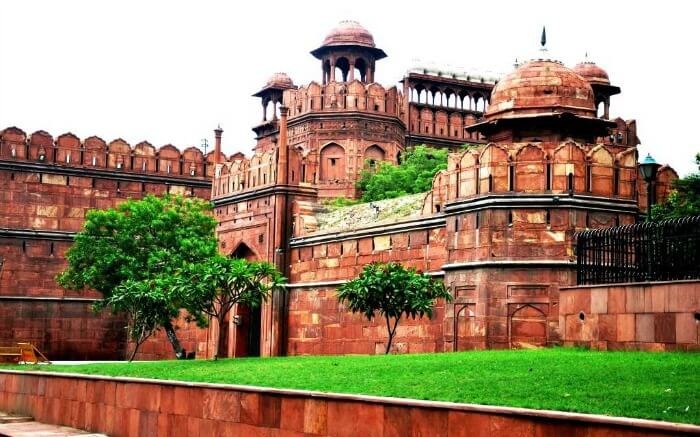
One of the historical tourist places in India, the Red Fort was constructed over ten years from 1638 to 1648. This fort was constructed when Shah Jahan shifted the capital from Agra to Delhi and it was then known as the Qila-e-Mubarak. This octagonal fort is one of the most famous historical places in north India and is also the site where the President gives his speech on Independence Day.
Interesting fact: The Red fort was actually white as it was made of limestone. The British painted it red when the limestone started chipping off.
Entry fee: Indians- INR 10
Foreigners- INR 250
Foreigners- INR 250
Open from: 9:30am- 4:30pm daily (Closed on Mondays)
Must see: The Palace of Colors or the ‘Rang Mahal’ where the emperor’s wives, mistresses and maids resided.
4. Qutub Minar, Delhi – A towering red sandstone minaret
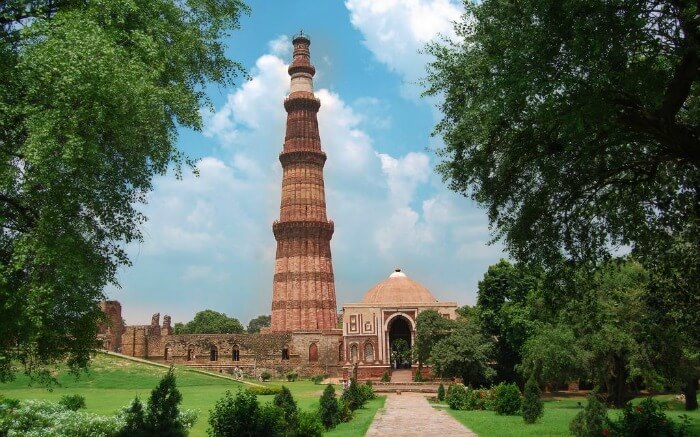
Regarded as the site of the first Muslim kingdom in northern India, the Qutub Minar is definitely one of the most historical sites in India. It is one of the finest examples of Indo-Muslim architecture with its intricate red sandstone storeys. These are dotted with carvings and verses from the Quran and are mostly in Arabic and Nagari.
Qutub Minar is one of the famous historical places in India and is said to have got its name from Qutb-ud-din Aibak who was the first Muslim ruler of North India. The first mosque in India Quwwat-ul-Islam Masjid is also located at the foot of the Qutub Minar.
Interesting fact: The Qutub Minar complex has an iron pillar that has not rusted even after 2000 years.
Entry fee: Indians- INR 10
Foreigners- INR 250
Foreigners- INR 250
Open from: 7am- 5pm
Must see: The Decorative Light Show held every evening from 6:30 to 8pm and the Qutub Minar Festival that is held in October/November.
5. Humayun’s Tomb, Delhi – Pay a visit to India’s first garden-tomb
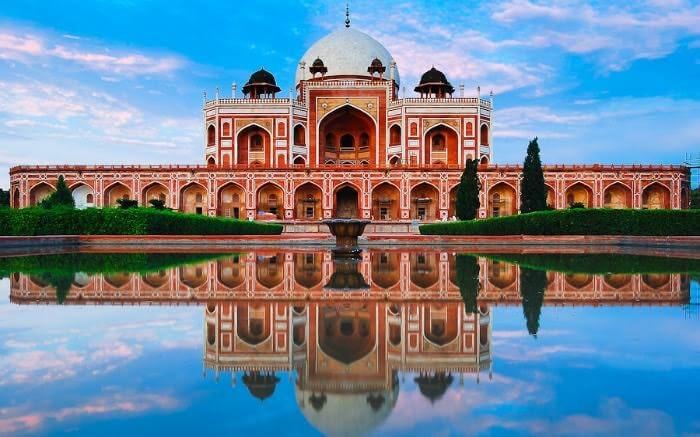
A beautiful synthesis of Indian and Persian architecture, Humayun’s Tomb is one of the most famous and important places in India. Humayun’s wife Hamida Banu Begum commissioned the building of this tomb for her husband in the 15th century. Arched alcoves, beautiful domes, elaborate corridors and kiosks – all make this monument a grandeur of Indian architecture. There is also a barber’s tomb at the southwestern side of the main tomb.
Interesting fact: Humayun’s Tomb was one of the main inspirations for the Taj Mahal.
Entry fee: Indians- INR 40
Foreigners- INR 510
Foreigners- INR 510
Open from: 7am to 7pm (Closed on Fridays)
Must see:‘The Dormitory of the Mughals’ that has over 100 tombs of the Mughal emperors
6. Fatehpuri Sikri, Uttar Pradesh – Experience the glory of the City of Victory
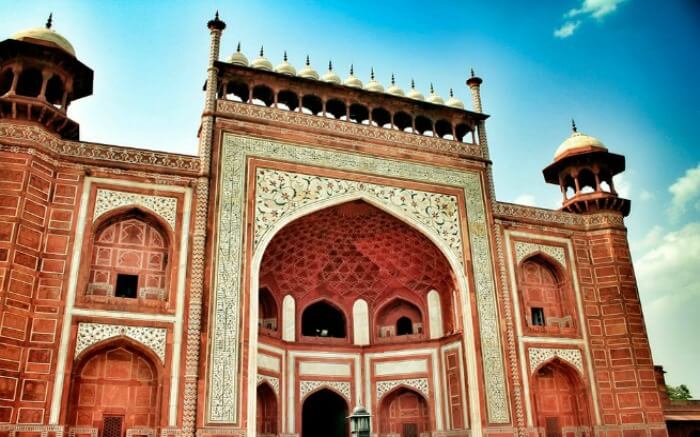
The royal city of Fatehpur Sikri was once the capital of the Mughal era during Akbar’s reign. This royal city is one of the historical tourist places in India and once had palaces, public buildings, mosques, quarters for the king, the army as well as the servants. Further, the well planned royal city with carved columns and decorated pillars was built between 1571-1573 AD and abandoned due to a shortage of water.
Interesting fact: Many barren women would come to the tomb of the Sufi saint Salim Chisti to pray for children.
Interesting fact: Many barren women would come to the tomb of the Sufi saint Salim Chisti to pray for children.
Entry fee: Indians- INR 40
Foreigners- INR 510
Foreigners- INR 510
Open from: Sunrise to sunset (Closed on Fridays)
Must see: Diwan-i-Aam and the Diwan-i-Khas
7. Hawa Mahal, Jaipur – A crowning glory in the pink city

The ‘Palace of Winds’ or Hawa Mahal gets its name due to the fact that it looks like a honeycomb of a beehive with its 953 intricate windows. It is also shaped like a crown as the ruler who built it, Maharaja Sawai Pratap Singh, was a major devotee of Lord Krishna. One of the popular tourist places in Jaipur, this palace is known as the tallest building in the world that doesn’t have any foundation. The palace is curved but still stands firm due to its pyramidal shape.
Interesting fact: It was believed that this building was created so that the royal ladies could look outside as they were constantly under ‘purdah’
Entry fee: Indians- INR 10
Foreigners- INR 50
Foreigners- INR 50
Open from: 9.30am-4.30pm
Must see: The intricate lattice work on the tiny windows.
8. Khajuraho Temples, Madhya Pradesh – Perfect embellishments of gods and goddesses
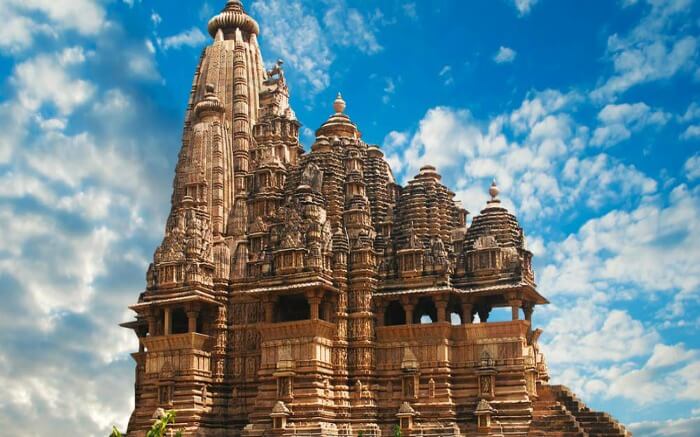
Khajuraho has always been thought of as the place that exemplifies sensuality and eroticism at its best. However this is a misrepresentation as only about 10 percent of the sculptures are sensual and the rest are common depictions. Countless sculptures depicting love, eternal grace, beauty, delicacy and the creative arts can be seen in one of the most historical places in India. A perfect amalgamation of Hinduism and Jainism, these temples have carvings of cult icons, demi gods and Apsaras.
Interesting fact: The city got its name as it was adorned with date palms and “Khajura’ means date palms in Hindi. It was also often called Khajjurpura in ancient times.
Entry fee: Indians- INR 10
Foreigners- INR 250 (only for the western temples, rest are free)
Foreigners- INR 250 (only for the western temples, rest are free)
Open from: Sunrise to sunset
Must see: The Sound and Light Show that portrays the tale of the Chandela dynasty.
9. Sanchi Stupa, Madhya Pradesh – Understanding the Life of Buddha
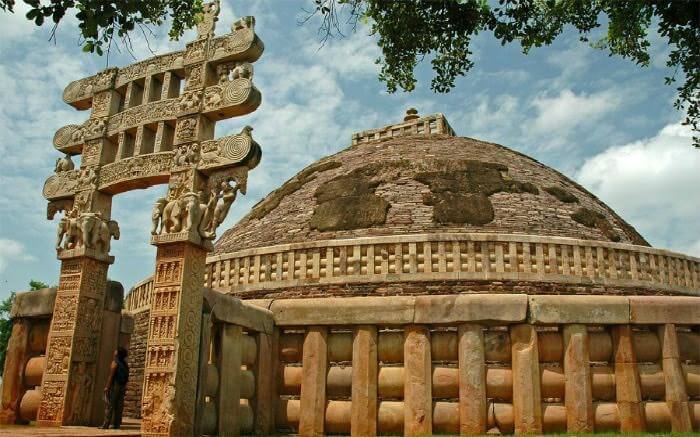
Unearth one of the most religious centers of Buddhism at the Sanchi Stupa that houses relics of the Buddha. This famous historical place in India was built by Lord Asoka in the 3rd century B.C for Emperor Ashoka. The Dome of the Stupa signifies the wheel of law and this stupa is actually considered as a symbol of Buddha’s freedom the circle of life and death (Moksha). The four gateways of the Stupa have various scenes from the Jataka tales and stories of Buddha’s life.
Interesting fact: The relics of Buddha were painted with a Mauryan polish to make them glow like glass.
Entry fee: Indians- INR 10
Foreigners- INR 250
Foreigners- INR 250
Open from: 8.30am-5pm
Must see: The Ashoka pillar has four lions and is designed in a Greco-Buddhist style. It is also the national emblem of India.
10. Konark Temple, Odisha – An ode to the Sun God

Built by the great ruler of the Ganga dynasty – King Narasimhadeva I, along with 1200 artisans, the Konark Temple is magic set in stone. Located on the coast of the Bay of Bengal, this temple signifies the exquisite detailing of ancient architecture and is one of the famous historical places in India. A particularly interesting feat is at the entrance of the temple where two lions are shown crushing elephants and a human body lies at the foot of the elephant.
Interesting fact: The 12 wheels at the base of the temple are sundials that accurately denote time.
Entry fee: Indians- INR 10
Foreigners- INR 250
There is no entrance fee on Fridays.
Foreigners- INR 250
There is no entrance fee on Fridays.
Open from: 10 am- 5pm ( Closed on Fridays)
Must see: The three statues of the sun gods where the sun’s rays fall at dawn, noon and sunset.
11. Mahabodhi Temple, Bodh Gaya – Attain enlightenment at the Buddhist sacred ground

Visit the Mahabodhi temples that are one of the four holy grounds of Buddhism. This is the spot where the Buddha is said to have attained enlightenment while meditating under a fig tree. The Bodhi tree is the descendant of the Fig tree and lies just near the temple. The earliest temple was built by Ashoka in the 3rd century BC. The temple has a massive statue of Buddha touching the earth with this right hand.
Interesting fact: The Bodhimanda is the spot under the Bodhi tree where the Buddha attained enlightenment. It is believed that this spot will be the last to disappear when the world ends and the first to reappear when the world is recreated.
Entry fee: None
Open from: 5 am- 9 pm
Open from: 5 am- 9 pm
Must see: The Jewel Walk here is the spot where the Buddha is said to have gone on a seven days walking meditation after he was enlightened.
12. Rani ki Vav, Gujarat – A stepwell of love for a king from his queen
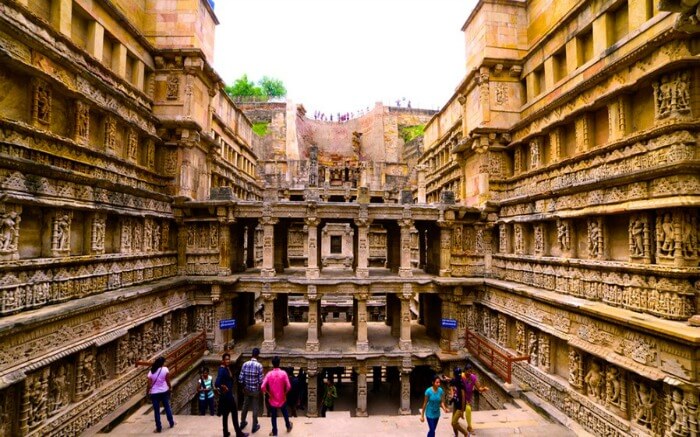
You will feel like an ant climbing down an anthill when you explore the Rani ki Vav stepwell as it is a massive structure that is around 24 meters deep. One of the most unexplored historical places in India, this stepwell was built in the 11th century AD, as a memoriam for King Bhimdev of the Solanki dynasty by his wife Queen Udayamati. The lowest level of the stepwell was earlier used as a route to escape to neighbouring villages.
Interesting fact: The central level has the theme “Dasavatars” which means 10 incarnations of Vishnu, and that when you approach the water level there will be a sculpture of Vishnu reclining on a thousand snake heads.
Entry fee: Indians- INR 5
Foreigners- INR 135
Foreigners- INR 135
Open from: 8 am to 6 pm
Must see: The excellently carved sculptures of Yokinis, Apsaras and Nakakanyas in the seven galleries.
13. Victoria Memorial, Kolkata – Get a sense of the British era
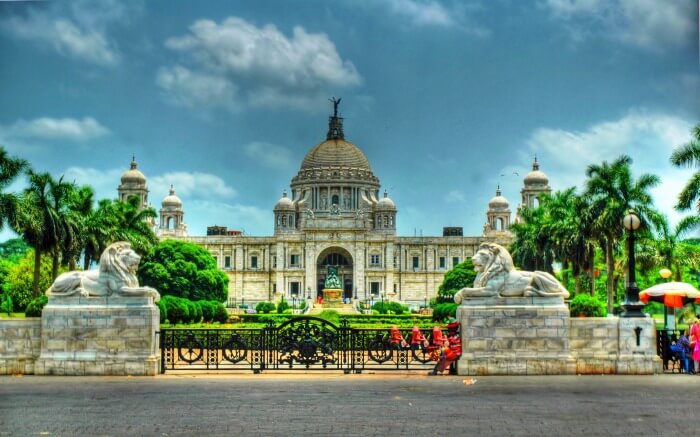
The Victoria Memorial in Kolkata is one of the most historical tourist places in India and was built during the peak of the British era in India. The then Viceroy Lord Curzon laid down the idea of this monument but its actual design was done by Sir William Emerson.
Multitudes of lush gardens, a museum filled with British memorabilia including weapons, paintings, sculptures, artifacts etc and royal portrait of the Queen are what you will find in this beautiful monument. One of the best paintings you will find here is the one by Russian artist Vasili Verestchagin. This painting depicts the Prince of Wales in Jaipur in 1876.
Interesting fact: There are two sets of mysterious inscriptions on the monument. One is “VRI” which means Victoria Regina Imperatrix and the other is “Dieu Et Mon Droit”. The first means Victoria Queen and Empress and the latter means “God and my right”.
Entry fee: Indians- INR 20
Foreigners- INR 200
Foreigners- INR 200
Open from: 5:30am- 6:15pm daily
Must see: The black bronze statue “Angel of Victory” that lies on the apex of the memorial’s dome. In favorable weather, it also acts as a weathercock.
Most Beautiful Historical Places in South India
14. Gateway of India, Mumbai – An iconic entry point to the city of dreams

Built as an access point for the entry and exit during the British period, the Gateway of India is one of the best historical places in India. This ancient gateway was completed in 1924 and was inaugurated by The Viceroy, the Earl of Reading. It has been reinforced over time using yellow basalt and concrete and has delicate lattice work all over the turrets. The statues of Chhatrapati Shivaji and Swami Vivekananda were also installed at the Gateway later on.
Interesting fact: The last of the British ships set sail for England from the Gateway of India in the 20th century.
Entry fee: None
Open from: 12am-12pm
Must see: There are steps behind the gateway from where you can take trips to Elephanta Island.
15. Ajanta & Ellora Caves, Aurangabad – Where art meets religion

The Ajanta and Ellora caves depict true craftsmanship skills where each rock carving was done by hand. When British officer John Smith set out to chase a tiger in 1819, he would never have thought that he would uncover the majestic Ajanta caves. These 29 caves are full of sculptures and paintings that epitomise Buddha and various Jataka tales.
Blending three different religions: Buddhism, Jainism and Brahmanism, the 34 caves at Ellora have been carved on the walls of a basaltic hill. There are 12 Buddhist caves, 17 Hindu caves and 5 Jain caves. Most of these caves are monasteries that were used for praying and studying.
Blending three different religions: Buddhism, Jainism and Brahmanism, the 34 caves at Ellora have been carved on the walls of a basaltic hill. There are 12 Buddhist caves, 17 Hindu caves and 5 Jain caves. Most of these caves are monasteries that were used for praying and studying.
Interesting fact: It is believed that the Buddhist monks were not allowed to go out during the monsoons and would sit and carve sculptures in the Ajanta caves.
Entry fee: Indians- INR 10
Foreigners- INR 250
There is no entrance fee on Fridays.
Foreigners- INR 250
There is no entrance fee on Fridays.
Open from: 9 am-5.30 pm ( Ajanta caves closed on Mondays & Ellora caves closed on Tuesdays)
Must see:
Ajanta: Cave 26 which is an elaborately decorated Chaitya hall with a stupa.
Ellora: The ‘Cavern of the Ten Avatars’ built under the reign of Krishna I.
Ellora: The ‘Cavern of the Ten Avatars’ built under the reign of Krishna I.
16. Charminar, Hyderabad – A tale of secret tunnels and giant arches
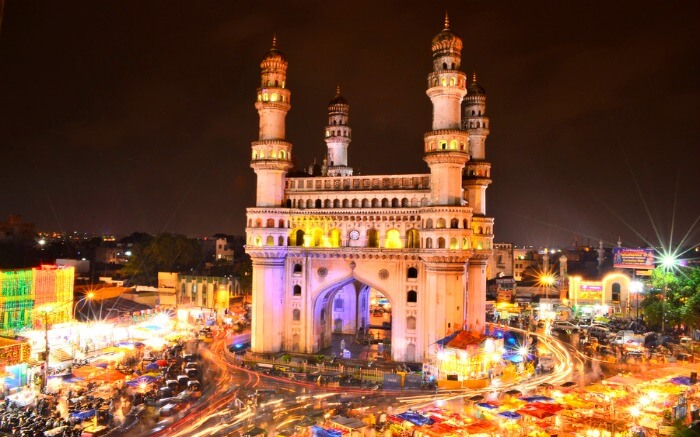
It was believed that Muhammad Quli Qutb Shah built the Charminar in 1591 to honor Allah. However in reality this historical tourist place in India was built to signify the end of plague in the city. Legend has it that there is a secret tunnel from the monument to Golconda fort but it hasn’t been discovered till date. Each minaret of this monument has four stories and every arch has one clock.
Interesting fact: There is a cat’s head in one of the arches in order to ward off rats that once almost destroyed Hyderabad.
Entry fee: Indians- INR 5
Foreigners- INR 100
Foreigners- INR 100
Open from: 9.30 am-5.30 pm
Must see: Laad Bazaar is an ideal spot to pick up a number of unique artefacts and there are several food joints in the market itself.
17. Mysore Palace, Karnataka – The shimmering abode of the royal family
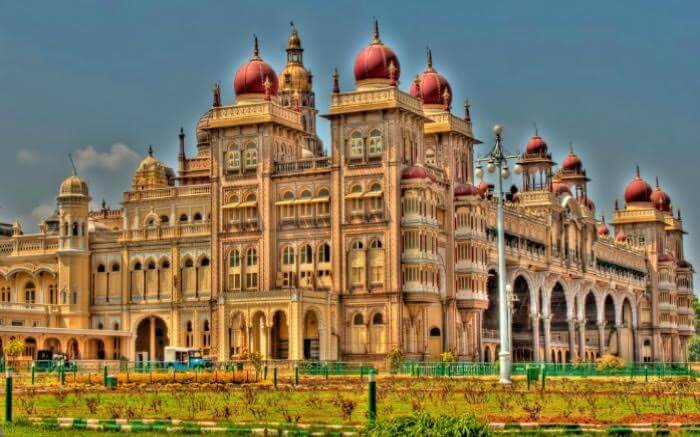
Once the royal abode of a number of rulers, the Mysore Palace is now a museum that has all the royal pictures, clothing and artefacts of the Wodeyar dynasty. This palace is one of the most historical places in India and is frequently visited by several tourists. The palace was built and refined by several emperors throughout the years and is thus an amalgamation of Hindu, Rajput, and Mughal styles making it one of the heritage destinations in India. Glazed tiles, chandeliers, and iron pillars adorn the pavilion inside the temple that is used to host royal weddings.
Interesting fact: The Maharajas used to earlier sit on a Golden palanquin that was then carried by elephants during the Dasara festival. Goddess Durga’s idol is now placed inside the palanquin.
Entry fee: Indians- INR 40
Foreigners- INR 200
Foreigners- INR 200
Open from: 10am-5.30pm (Closed on Sundays and govt holidays)
Must see: The way the palace is lighted up during the Dussehra festival with over 10,000 lights.
18. Hampi, Karnataka – A land replete with tales from The Ramayana
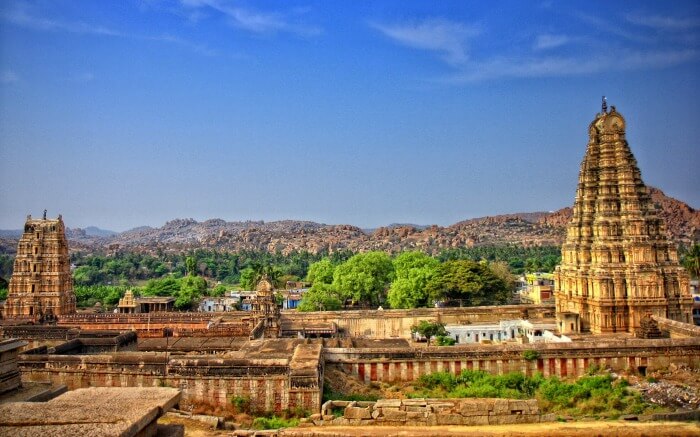
Hampi’s rocky outcrops, chariot structures, gopurams, elephant stables, ornate halls – all depict the tale of one of the greatest Hindu kingdoms. It is believed that Lord Rama and his brother visited this historical place to search for Sita. They took the help of the two brothers Bali and Sugriv who ruled this region then. This UNESCO World Heritage Site is one of the most famous historical places in South India and was also the region where Vijayanagara’s main coin mint was situated.
Interesting fact: The first instance of human settlement recorded here dates all the way back to 1 CE.
Entry fee: Indians- INR 10
Foreigners- INR 330
Foreigners- INR 330
This ticket allows entry to three ancient monuments: Vittala Temple, Zenena Enclosure and the Elephant stables
Open from: 10 am- 5pm ( closed on Fridays)
Must see: Hampi Monuments that have carvings from the 14th century!
19. Chola temples, Tamil Nadu – Explore the glory of the great living temples
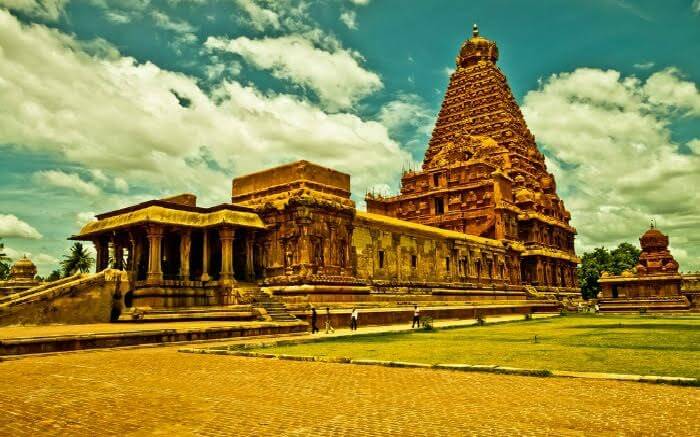
Get set to undertake an adventurous journey back in time by visiting the trio of three great Chola temples: Brihadeshwara Temple at Tanjore, Airavateshwara Temple in Darasuram, and Brihadeeshwara Temple in Gangaikonda Cholapuram. The three temples were built by the kings of Chola dynasty which was one of the greatest kingdoms of South India. The ones at Tanjore and Cholapuram were built in the 11th century while the one at Darasuram was built in the 12th century.
Interesting fact: Raja Raja Cholan was inspired to build the Brihadeshwara Temple at Tanjore due to a dream he had while visiting Sri Lanka.
Entry fee: None
Open from: 6.30 am – 8.30pm (The temples are shut from 12 pm to 4pm)
Must see: The first royal portrait at Brihadeshwara Temple where Raja Raja Cholan can be seen paying obeisance to Lord Natarajar.
20. Mahabalipuram, Tamil Nadu – Monolithic depictions of the Mahabharata
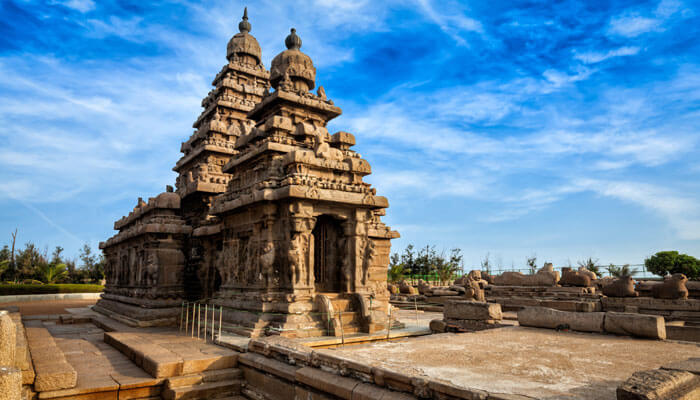
Dravidian-style temples dotted with innumerable sculptures are the major attractions of Mahabalipuram. The stone carvings display Pallava art and took over 200 years to create making this one of the most ancient historical places in India.
11 temples called Mandapas lie on both sides of the hills at Mahabalipuram and these have both Dravidian style architecture as well as several Buddhist elements. The Shore Temple, Arjuna’s Penance and the Cave temples are some of the most popular tourist attractions of this region.
Interesting fact: The “Descent of the Ganges” that has been carved from pink granite and displays how Lord Shiva made the water of the Ganges descend from the heavens onto the earth.
 cleodganj & Dalhousie With Her Husband And Friends
cleodganj & Dalhousie With Her Husband And Friends

Comments
Post a Comment